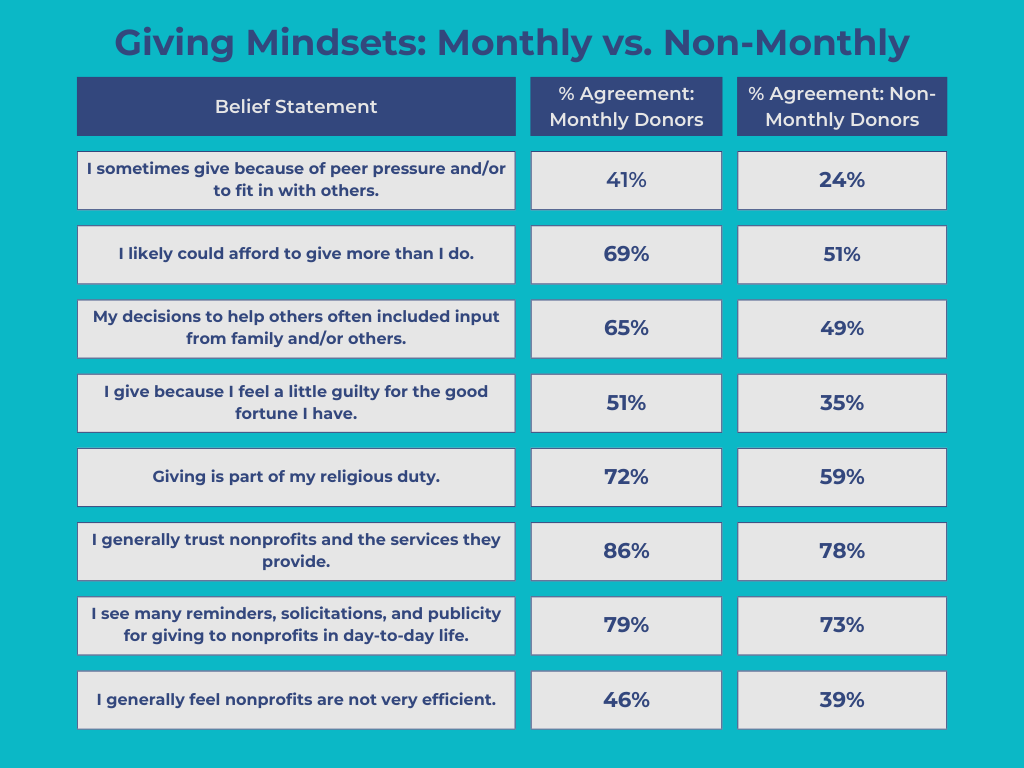Monthly donors are essential members of a nonprofit community. They are loyal, consistent, and often deeply engaged with your mission. But what is the profile of a recurring giver, and how do they differ from your one-time givers, if at all?
To help us answer this question, we dug into our GivingPulse research. Since 2022, GivingTuesday has conducted a weekly cross-sectional online survey of Americans totaling ~23,000 responses that tracks self-reported generous actions in the past week and their associated attitudes and worldview. We took a look at our 2024 findings (January 2024-March 2025) to see if we could get a snapshot of today’s recurring donor. Here’s what we learned.
The Basics: How Common Are Monthly Givers?
In this analysis, we define recurring givers as individuals who have indicated that they give money automatically from a bank account or credit card on a monthly basis. This question is asked of anyone who indicated that they gave money to any recipient type on the GivingPulse survey.
- 30% of monetary givers report giving monthly.
- That’s 11% of all survey respondents.
One important callout: We recognize that different definitions of “recurring giving” exist in the field, including those who give regularly on a quarterly or even annual basis. For the purposes of this research, we are specifically looking at monthly recurring givers.
Who They Are: Demographics
Monthly givers are more likely to be:
- Under 35 — 36% give monthly.
- Full-time employed — 35% give monthly.
- Living with Children — 36% of those with children at home give monthly, compared to 27% of people without children living at home.
- Urban dwellers — 38% give monthly.
- Higher income — 36% of those earning over $100K give monthly.
- Highly Religious — 40%, almost double those who report that they are “not at all” religious, give monthly.
What is less of a factor? There were insignificant variations in recurring giving rates among subgroups of the following demographic traits: gender, region of residence (across the U.S.), ethnicity, or language spoken at home.
Note: All percentages refer to the share of donors within each subgroup who report giving on a recurring (monthly) basis, not the percentage of monthly donors that have a specific trait. For example, highly religious people are the most likely to be recurring donors because 40% of highly religious people who gave money did so on a monthly basis, compared with 22% of non-religious people. As another example, people under 35 are more likely to be recurring donors because 36% of people under 35 that give money do so monthly, compared to 27% of people over 35.
How They Think: Attitudes and Motivations
Monthly givers tend to be more reflective and socially influenced in their giving decisions. They are more likely to report giving due to feelings of responsibility, social expectations, and religious beliefs. Monthly givers also express both higher trust in nonprofits yet greater scrutiny of nonprofits efficiency.
There are a few core beliefs about giving where monthly and non-monthly givers tend to agree. For example, both groups responded similarly to the following statements:
- I feel everyone has a responsibility to give and help those in need.
- I enjoy giving to nonprofits.
- As a child, I was raised to help others and to give to nonprofit organizations.
- It is so easy to make a donation to nonprofits nowadays.
- Giving to nonprofits is full of unknowns.
Note: The attitudes section is comparing the 30% of monetary givers that give monthly to the 70% that are monetary givers but did NOT give monthly. Attitudes are measured on a four point likert scale – “Strongly disagree”, “Somewhat disagree”, “Somewhat agree”, “Strongly agree”.
What They Do: Giving Behavior
Compared to other donors, monthly givers are:
- More generous with time and other forms of participation:
- 57% volunteer (vs. 39%)
- 67% give items (vs. 58%)
- 40% give through work (vs. 17%)
- 90% give to registered charities (vs. 74%)
- More likely to support less frequently supported causes:
- Human rights (13% vs. 6%)
- Environment/climate (10% vs. 4%)
- International poverty relief (12% vs. 8%)
- Education/literacy (12% vs. 8%)
Interestingly, solicitation rates do not differ significantly between monthly and non-monthly givers: 41% of non-monthly givers had been solicited in the past week (67% in the past month) compared with 40% of monthly givers (70% in the past month).
However, they are more tuned in to nonprofit buzz—both good and bad. 61% have seen positive nonprofit news recently (vs. 48%), and 20% caught something negative (vs. 13%).
Note: The giving behavior section is comparing the 30% of monetary givers that give monthly to the 70% that are monetary givers but did NOT give monthly.
What This Means for You
Monthly givers aren’t vastly different from non-recurring donors, but they do stand out in some important ways.
They tend to be younger, employed full-time, higher-income, and raising families in urban areas. They’re also more religious, more motivated by social and emotional factors (like peer influence and a sense of duty), and more likely to engage across multiple giving channels—including volunteering and workplace giving.
At the same time, they share many traits with non-monthly givers: they’re just as likely to support major causes like animal welfare, crisis response, and domestic poverty relief, and just as likely to give informally to individuals or unregistered groups. They’re also not being asked to give more often than anyone else—just more likely to say yes on a regular basis.
So what can you do?
- Target your outreach to the profiles of monthly donors. These may look different in your own organization, so try to learn more about the profile of your recurring donors. If you are starting from scratch, try utilizing the profiles we’ve outlined.
- Speak to their motivations of consistency, social identity, and a sense of responsibility or shared values.
- Be transparent and show your impact. Monthly givers tend to trust nonprofits more, but they’re also more attuned to inefficiencies.
- Make it easy for recurring donors to give in multiple ways. These donors are more likely to volunteer, give through work, and support less mainstream causes. This also means you can utilize your network of volunteers to target potential new recurring donors.
- Don’t hesitate to ask. Monthly givers are saying yes at the same rate they’re being asked.
Want more data like this? Check out GivingPulse and the GivingPulse Field Guide for ongoing insights to help you understand—and grow—your community of givers.




